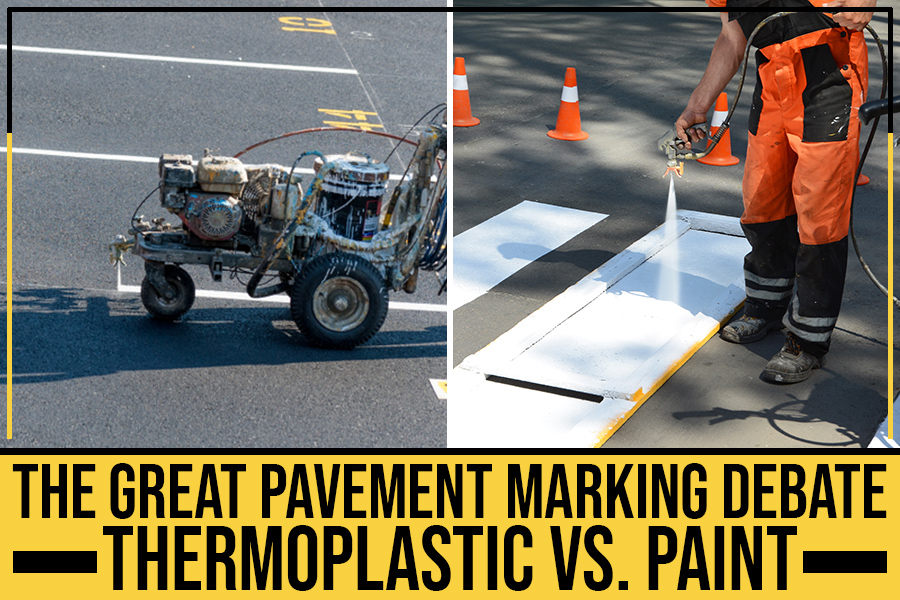Key Takeaways:
- Thermoplastic markings have a longer lifespan and are more durable than paint markings.
- Thermoplastic markings require less maintenance, resulting in lower long-term costs.
- The environmental impact of thermoplastic should be considered due to its petroleum-based manufacturing process.
- Overall, thermoplastic is a more cost-effective and sustainable option for pavement markings.
- Landmark Paving offers pavement marking and striping services to customers in Daytona Beach, FL, and the surrounding areas.
There is an excellent debate between business owners, city planners, and other professionals over what type of pavement markings to use: thermoplastic or paint. Both have pros and cons, but which should you choose for your business? Landmark will explore the benefits of both markings and help you decide which is best for you!
What Are Pavement Markings?
Pavement markings are lines, symbols, and other markings that are painted or applied to the surface of a road or highway. They are used to convey information to drivers. They can be used for several purposes, such as indicating the edge of the road, marking lanes, and indicating the location of crosswalks.
What is Thermoplastic?
Thermoplastic is a material that becomes soft and pliable when heated and hardens when cooled. It is often used in pavement markings because it can be applied quickly and easily to the road surface. Thermoplastic pavement markings are typically made from polyvinyl chloride (PVC) resin bases combined with other ingredients such as pigments, fillers, and plasticizers.
1. Advantages of Thermoplastic
Thermoplastic pavement markings have several advantages over paint-based markings. Thermoplastic markings are more durable than paint markings and can last up to 10 times longer. They are also more resistant to fading from sunlight and less likely to be damaged by vehicles. Thermoplastic markings can be applied in a broader range of temperatures than paint-based markings.
Using thermoplastic road markings is one of the best ways to improve road safety. Thermoplastic markings are highly reflective, making them much easier to see at night or in bad weather conditions when visibility is poor.
Thermoplastic markings are thicker and more durable than regular paint, which is why they are often used for rumble strips. These specialized stripes provide drivers with physical feedback in the form of noticeable vibration and audible rumbling noise, warning them of upcoming danger spots. It then helps to avoid collisions and accidents.
2. Disadvantages of Thermoplastic
Thermoplastic pavement markings have a few disadvantages when compared to paint-based markings. Thermoplastic materials can be more challenging to remove than paint-based materials, making them less ideal for areas where repainting or resurfacing may be necessary in the future. Additionally, thermoplastic materials can be susceptible to damage from heat sources such as welding torches or cigarette butts.
What is Paint?
Paint is a coating applied to a surface to protect it from the elements or to change its appearance. Pavement paint is typically made from a base of asphalt emulsion combined with other ingredients such as pigments, fillers, and binders.
1. Advantages of Paint
Paint-based pavement markings have several advantages over thermoplastic markings. Paint-based markings are typically less expensive than thermoplastic markings. They can also be applied more quickly and efficiently than thermoplastic markings. Additionally, paint-based markings are more resistant to damage from chemicals and salt than thermoplastic markings.
2. Disadvantages of Paint
Paint-based pavement marking has a few disadvantages when compared to thermoplastic materials. Paint-based materials can fade faster than thermoplastic materials when sunlight or other UV light sources are exposed. They can also be damaged more easily by vehicles or other objects coming into contact with them. Additionally, paint-based materials can be more challenging to apply evenly than thermoplastic materials.
Which Is Better? Thermoplastic vs. Paint
There is no straight answer as to which pavement marking material is better. It ultimately depends on the specific needs of the project. For example, thermoplastic would be better if durability is a crucial concern. However, if cost is a significant factor, then the paint would be the better option. Here are a few factors to help you determine which option will suit your needs.

1. Cost
The primary consideration when choosing a pavement marking material is cost. Thermoplastic is typically more expensive than paint but has a longer lifespan. Paint is cheaper upfront, but it will need to be reapplied more often, ultimately increasing costs.
2. Durability
Durability is another crucial factor to consider. Thermoplastic is much more durable than paint and can last several years without needing to be replaced. Paint is not as durable and will typically only last for a couple of years before it needs to be reapplied.
3. Visibility
Visibility is an important safety consideration when choosing a pavement marking material. Thermoplastic markings are highly visible, even in low-light conditions such as nighttime or inclement weather. Paint markings are not as visible, especially in low-light situations or when wet.
Also, read our blog on pavement markings.
4. Reflectivity
Reflectivity is another safety consideration when choosing a pavement marking material. Thermoplastic markings are highly reflective, which makes them easier for drivers to see at night or during inclement weather. Paint markings are not as reflective and can be difficult for drivers to see in low-light conditions.
5. Installation Process
The installation process is another factor when choosing a pavement marking material. Thermoplastic markings are installed by melting the material and then applying it to the pavement surface. Paint markings are applied using brushes or rollers and require drying time before traffic can resume on the roadway.
6. Maintenance
Maintenance is another factor to consider when choosing a pavement marking material. Thermoplastic markings do not require much maintenance and can typically last several years without needing to be replaced. Paint markings require frequent maintenance and must be reapplied every year.
7. Environmental Impact
The environmental impact of the chosen pavement marking material should also be considered. Thermoplastic is made from petroleum products and can release harmful chemicals into the environment during its manufacturing process. Paint is also made from petroleum products, but its environmental impact is generally lower than that of thermoplastic due to its shorter lifespan and less frequent replacement cycle.
Click here to explore more options for pavement markings.
Need Pavement Marking Services in Daytona Beach, FL? No Problem!
Contact Landmark if you need pavement marking services in Daytona Beach, FL, or the surrounding area. We offer a wide range of pavement markings, parking lot maintenance, and signage services that meet your needs. Plus, we’re happy to provide free estimates so you can see how much you can save by using our services.
Contact us today to get started!




